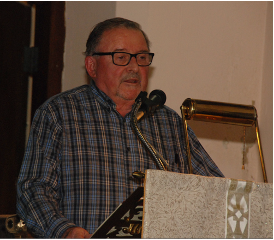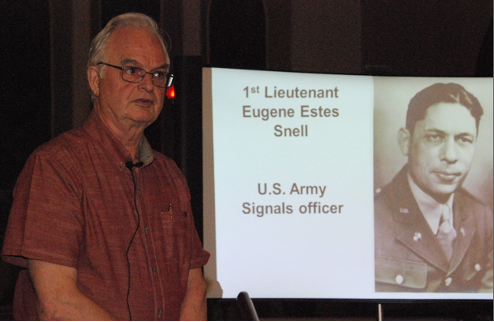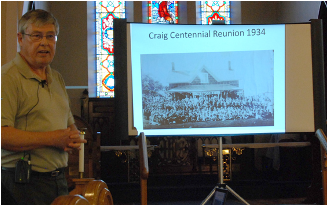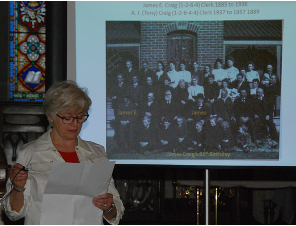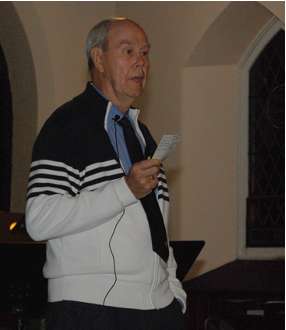3 Presentations: The Craigs of Rideau Township; Life & Death of Pilot Officer Tommy Watterson; County Reeve William Cowan
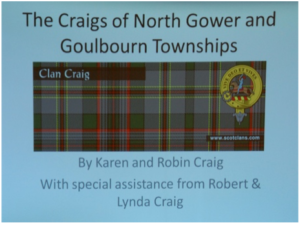
Karen, Robin, and Robert Craig, Owen Cooke, and Bill Tupper. Article by Scott Cameron, Photos by Maureen McPhee. May, 2018.
The May meeting featured three presentations by RTHS members.
The Craigs of North Gower and Goulbourn Townships
The Craig Family Karen, Robin, and Robert Craig, detailed the history of the Craig family. and their journey from Scotland which eventually brought them to North Gower.
The family line begins with two brothers, given names unknown, emigrating from Ayr, Scotland in the 1700s to Enniskillen, in County Fermanagh, Ireland, with their families. In 1760 one of the Craig brothers moved to neighbouring County Cavan in the Town land of Monesk, in Killinagh Parish in Barony with his wife and two children Thomas and Elizabeth.
Thomas Craig (I) would marry and settle on a rented farm in Monesk with his wife and nine children. This is where the connected line of Craigs begins.
A son, Thomas Craig (II), would marry Elizabeth Moffatt in 1815 and continue farming in Monesk until the Irish famine prompted him, along with his 8 siblings, to emigrate.
The Craigs, all children of Thomas (I) would leave Ireland in two waves, both departing from the town of Sligo in Sligo County. The first wave, leaving Friday, May the 2nd, 1834 aboard the Richardson, included Hugh Craig, his wife and seven of their nine children, three of whom had families of their own, for a combined total of twenty-nine.
After several months of ocean and river travel, the Craigs arrived in Brockville. From there, they made their way to Goulbourn Township through the forest by wagons and oxen.
The next wave of Craig emigrants, departing SIigo April 1st, 1840 on the ship Industry, consisted of Thomas (II) with his wife and their eleven children. Their party also included several members of the Moffatt family, relatives of Thomas's wife Elizabeth. Upon arriving in Montreal the travelers followed the Ottawa River to Bytown, where they were met by Hugh Craig's son James. From there they reached North Gower Township.
Thomas's family lived three months with a cousin, Robert Graham, before settling on a plot of their own for one year, then permanently moving to Lot 13, Con. 2, North Gower Township.
An interesting family tale was recounted concerning an American sea captain who came seeking the hand of Thomas's daughter Charlotte. Upon hearing of the suitor's imminent arrival, Thomas sent Charlotte to hide in the neighbouring Mitchell farm. When the captain arrived, he was told that Charlotte had left. Charlotte would ultimately marry the Mitchell family's son Thomas.
Robert then explained the direct link that he has to Thomas (I) through a numbering scheme used by James Beverly Craig in his book The Craigs of Goulboun and North Gower by delineating which ancestor in the family tree you are related to based on their order of birth. A poem written by Thomas (II) was read by Karen.
The Life and Tragic Death of Pilot Officer Tommy Watterson of Carleton County.
Thomas Albert Kidd Watterson was born on March 13th 1912 in Ottawa to Dr. J. Watterson and Jesse Watterson (nee Fallister). Thomas attended Percy Street Public School, and graduated from Lisgar Collegiate in 1933.
The family moved to a farm on the corner of First Line and Century Road, an intersection now known locally as Watterson's Corners. Thomas joined the Militia at age 23, serving in the Royal Canadian Army Medical Corps. He then joined the Marine Section of the RCMP as a Seaman in 1937, enrolling in the Commercial Mates Course. In July of 1940 he joined the RCAF and was trained in St. Eugene, Ontario on the Finch Fleet biplane, graduating as a sergeant pilot.
In 1942 Thomas was sent to Dartmouth to serve in No. 11 (Bomber Reconnaissance) squadron. Flying a Lockheed Hudson, he was tasked with protecting convoys, and while he flew many sorties and fought in the battle of the Atlantic, he never sighted a submarine.
He was eventually moved to the No. 145 (BR) Squadron in St. John's. Newfoundland. In December of 1942, Thomas was commissioned as a Pilot Officer.
On the night of February 13, 1943, Watterson was tapped to fly a navigation exercise and transport from St. John's to Dartmouth in poor flying conditions that included freezing drizzle. The crew included Wireless Operator Flight Sergeant James Robin Stick of St. John's Newfoundland, Navigator Flight Sergeant Robert Cecil Rolfe of Huntingdon, Quebec, and passengers Flight Lieutenant John Thomas Hook of Brockville, Ontario, Flight Lieutenant William Hector Thompson from Ottawa Ontario, and American 1st Lieutenant Signal Officer Eugene Snell of Arkansas.
Contact with the plane was lost during the flight. While an RCMP officer claimed to have heard the plane circling over Cape Breton air space, the wreckage was ultimately found by hunters in November 1944, eleven miles from Dartmouth. The plane had run out of fuel.
The skulls of the survivors were identified by the families, with Watterson being identified by his epaulet. Although Watterson had been recommended for the Air Force Cross before his disappearance, the award could not be awarded posthumously. Consequently, he was mentioned in Despatches of December 11th 1943. His remains were returned home. and he now rests in Elmview Cemetery in Kars, Ontario.
The Exploits and Tragic Passing of Former County Reeve William Cowan
Born in County Leitrim, Ireland, William Cowan received formal training as a teacher. Immigrating to Canada in 1845, he settled in North Gower, where he taught school for five years
William married Caroline McCrea in 1850, and purchased four lots for them to farm in North Gower Township..
Cowan first served as the Militia Captain of the 5th battalion in 1855. He was Councilor for the area from 1858-1869, and County Reeve from 1865-1869. He was named Warden of the County in 1866, and served as County Clerk from 1870-1872.
In 1873, he was appointed Treasurer of the County, and in 1878 Clerk of the Divisional Court, holding both positions until his death. His service also included Waterworks Commissioner for the City of Ottawa. On Saturday, January 7th 1899, tragedy struck. On that day, Cowan set out with his son Holmes, and the driver of his two-horse carriage to pay his respects at the funeral of friend Charles O'Gara. The drifting snow caused the horses to be nervous, and as the carriage approached the train tracks, the oncoming train sounded its loud whistle, further frightening the horses, who bolted directly into the train.
William and his son Holmes both died, but his driver survived. Upon hearing of the tragedy, the O'Gara family covered the entire cost of the funeral. The Cowans' funeral service was held at St. John's church on Bell Street on January 9th1899. He left behind a widow and seven children. Along with his extensive involvement in Municipal Government, William Cowan was also an Episcopalian, a Free Mason, and an Orangeman.
